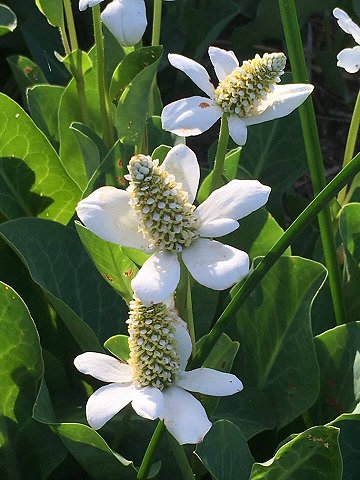
|
|
Yerba Mansa (Anemopsis californica). Leaves and
flowers.
|
Yerba Mansa - Anemopsis californica
The monotypic genus Anemopsis has only one species, Anemopsis californica, with the common names yerba mansa or lizard
tail, ÔŮ Apache beads. It is a perennial flowering
herbal plant in the lizard tail family (Saururaceae), native to
southwestern North America, and prefers very wet soil or shallow water. The plant has been described by local residents as magical, its qualities almost mythical.
It forms a clump of broad green leaves. As it matures, the visible part of the plant develops red stains, eventually turning bright red in the fall.
Yerba mansa is showy in spring when in bloom. From
leaves, unusual white, sweet-scented flowers, often flushed with pink, appear from July to September.The iconic white "flowers" (actually reduced inflorescences, or pseudanthia) are borne in early spring, and are surrounded by 4Ė9 large white spoon-shaped
bracts like petals.
Similar to the family Asteraceae, what appears to be a single bloom is in reality a dense cluster of individually small flowers borne in an inflorescence. In this species the inflorescence is conical and has five to ten large white bracts beneath it, so that along with the tiny white florets, the whole structure is quite striking when it blooms in spring. The conical structure develops into a single, tough fruit that can be carried downstream to spread the tiny, pepper-like seeds.
Yerba Mansa requires moist soil, so best to plant in streambeds, seeps or other damp areas. It goes dormant and basically disappears from late summer to early winter, and re-sprouts from the roots in late winter. It produces beautiful white flowers in the early spring that remain on the plant until it starts to go dormant in late summer. It will often spread out like a carpet throughout the damper soil, and choke out any other plants in the area, and in particular while it's blooming, it's quite beautiful. Itís a great choice for growing at the edge of a pond or in a bog garden.
The botanical name for the genus comes from the Latin combination of 'Anem' from "Anemone" and 'opsis' meaning "like" or "resembling" from this
plant resemblance to an anemone.
In common name, Yerba Mansa translates from Spanish as the calming herb. It has been used by American Indians and Hispanics for centuries for ailments such as toothaches and sinus infections.
Yerba mansa is one of those names which confounds linguists. Yerba is Spanish for herb, and thus one would think that mansa is also from Spanish as well, but all indications point to the fact that it is not. Mansa means tame, peaceful, calm in Spanish, and the plant has no sedative effect, nor did local people ever use it as a calming agent. Its primary use is as an antimicrobial, antibacterial, and antifungal. The most likely explanation is that mansa is a Spanish alteration of the original native word for the plant, now lost in the depths of
time.
Hartweg, who collected it at León, Guanajuato, Mexico in 1837, recorded the local name as yerba del manso. It is also known as yerba del manso in northern Baja California. The word "manso" could be short for "remanso" (backwater) which would agree with the areas where the plant thrives.
Parts of the plant are edible. The pulverized seeds are made into bread or cooked as a mush. The peppery aromatic root is astringent and is chewed raw for medicinal purposes.
Yerba mansa was widely employed by the native North American Indians to treat a wide variety of complaints. It is little used in modern herbalism. The whole plant is analgesic, antiperiodic, antiphlogistic, blood purifier, disinfectant, diuretic, laxative, stomachic and vulnerary. The plant is infused and used to bathe aching muscles and sore feet. The root is chewed for affections of the mucous membranes. A tea made from the root is used as a blood purifier and general pain remedy, and as a treatment for pleurisy, gonorrhoea, syphilis and menstrual cramps. An infusion of the plant is used in the treatment of colds, chest congestion and stomach ulcers. The dried and powdered plant is used as a disinfectant on wounds whilst the fresh moist leaves are used as a poultice or salve on burns, cuts and wounds. An infusion of the bark is used as a wash for open sores.
Source:
https://en.wikipedia.org/wiki/Anemopsis
https://pfaf.org/user/Plant.aspx?LatinName=Anemopsis+californica
https://calscape.org/Anemopsis-californica-(Yerba-Mansa)
